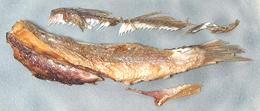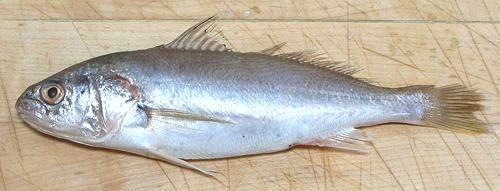
Pan dressed White Croaker

Pan fried White Croaker with
Fins pulled out.
This is a good eating fish, except for the size. It's a bit too small to fillet, so best to pan dress it and pan fry or poach it in that state. I usually pan fry with a light dusting of rice flour to keep it from sticking. Use simple light sauce that won't mask the moderate flavor of the off-white flesh. I usually use my Lemon Wine Sauce for fish.
I always eat small fish like this with pointy chopsticks. This makes finding pin bones and the like easier, but some will still get through and have to be removed from the mouth.
Buying: This fish sometimes appears in the Philippine fish markets here in Los Angeles, close to it's center of the fish's population. It will not be found in most of North America due to its limited range and modest numbers.
Pan Dressing: Forget your filleting knife, it isn't the right tool for this fish. You need a sharp pare of kitchen shears.
- Scale the fish. There will be only a few small scales down near the tail, and they scrape off very easily.
- Cut off the head with kitchen shears, down behind both pectoral and pelvic fins.
- With the shears, cut the belly open back to the vent.
- Scoop out all the innards. They are mushy, but with some membranes that have to come out. The inside should be clean down to the backbone.
- Cut away the skirt, it is very thin so there is no susbstantial loss of flesh.
- If pan frying, dust lightly with rice flour to prevent sticking. First fry on one side, then the other. The body cavity will now be so wide, you can finish it sitting right side up.
- After cooking, pull the top and bottom fins out to make eating easier. This is easy and can be done before serving or by the diner on the plate. There will still be some thread fine ribs to deal with on the plate, but the only way to avoid that is to sacrifice all the flesh below the backbone for the first third of the fish.
Fillet: This fish is really too small to fillet, but I've done it for the measurements. It fillets fairly easily, if you are good at working delicately on small objects. When you get to the ribcage, you can probably just pull the fillet off the ribs, then remove any still in the fillet with long nose pliers. The ribs are long, thread thin, and slant sharply towards the tail.
Yield: A 2-7/8 ounce fish yielded 1-1/8 ounces of skin-on fillets (39%). I made no attempt to skin the fillets. Pan dressed, your effective yield would be a little higher.
Skin: Skin shrink is severe and does not immediately relax. On the other hand, it doesn't have strong adhesion, so you can fry fillets skin-on if you cook most of the way through before turning skin side down. Pan dressed fish can be pan fried, deep fried or even poached without problems. The skin shrink will just stretch open the body cavity a bit.
Stock: Because this fish is almost always cooked pan dressed, there isn't much to make stock with except heads. I did not give that a try.
 [Kingfish, Pasadena Trout; Corvina bianca (Spanish);
Genyonemus lineatus]
[Kingfish, Pasadena Trout; Corvina bianca (Spanish);
Genyonemus lineatus]